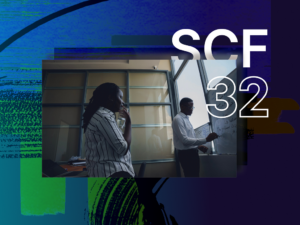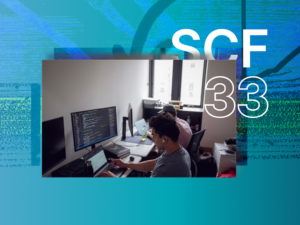
The Stellar Community Fund (SCF) is an open-application awards program that draws on community input to support developers and startups building on Stellar. The SCF Build Award operates in 6-week rounds, including two-step panel review process and community vote.
We received 77 submissions, 38 of which were submitted for their first ever SCF Build awards. Thank you to all submitters and reviewers for your hard work!.
SCF #39 set a new standard, packed with innovative ideas that push the boundaries of what’s possible in the Stellar ecosystem. This round saw a remarkable rise in creative collaboration as teams built alongside existing wallets, on/off-ramps, and DeFi protocols — to strengthen the network’s connectivity and scalability. The newly awarded SCF Build projects are ambitious, impactful, and ready to shape the next phase of network growth.
12 projects were awarded a total of $1,115,655 worth of XLM.
Click on the project name to view their successful submission! Please note that in order to view the SCF Dashboard, you need to be logged in. If you do not yet have an account, you can create one by signing up with Discord.
Build Award Recipients
Projects can request an SCF Build Award up to $150,000 worth of XLM*. The SCF Build Award is for projects which have significant (user) traction OR teams that are experienced in the Stellar ecosystem and have identified a validated need, both with a well thought out plan and architecture to be ready to build upon receiving the SCF Build Award. Learn more in the SCF Handbook.
QuillTip: Publishing and Microtipping– $37,200 worth of XLM*
QuillTip is a platform enabling readers to tip text highlights in articles for a few cents, writers earning directly on Stellar.
Stallion– $50,000 worth of XLM*
Stallion is a decentralized bounty platform on Stellar, connecting global Web3 talent with projects through transparent on-chain payments and automated supported token rewards on Stellar.
Synced Geo-Bounties — $78,375 worth of XLM*
Synced Geo-Bounties are a large scale release of synced and geo-bounties to support coastal communities along the Eastern Americas with creating real-time sargassum monitoring maps.
Dolphinze– $129,800 worth of XLM*
Dolphinze, a recent Draper University Builder Residency graduate, is building the next generation of global payroll infrastructure — designed specifically for contractors and powered by crypto-native rails like Stellar.
Soroban SDK Tools — $60,000 worth of XLM*
Soroban SDK Tools is developing the soroban-sdk-tools crate to help Stellar smart contract developers streamline storage, error handling, and unit testing.
DevAsign — $80,000 worth of XLM*
DevAsign streamlines open-source project management by automating bounty payouts and intelligently handling pull requests with advanced AI review.
Inference — $149,730 worth of XLM*
Inference is designed as a domain‑specific formal specification language for Web3 native applications that seek to bridge the gap between theorem proving and practical application development in blockchains.
RendBit– $120,000 worth of XLM*
RenBit is a Stellar-powered cross-border banking platform helping Africans move, convert, and save money, without middlemen, or high fees.
OneKey– $150,000 worth of XLM*
OneKey envisions a future where users can seamlessly and securely manage Stellar assets, leveraging industry-leading hardware and software wallets to drive broader adoption of the Stellar network.
AIDA– $47,000 worth of XLM*
AIDA offers an AI-powered multi-chain platform that helps creators and traders launch, promote, analyze, and trade tokens — including RWAs — seamlessly across blockchains, with native Stellar integration.
Lumen Later– $131,550 worth of XLM*
Lumen Later offers near-instant, low-fee BNPL on Stellar to help global merchants and users access credit, enabled by Stellar smart contracts and native USDC.
Congratulations to these standout projects! We’re inspired by the innovation you’ve brought forward and can’t wait to see your growth across the ecosystem. We look forward to collaborating closely and helping you transform these ideas into lasting impact.
Round Insights & Voting Dynamics
Since October 2023, the Stellar Community Fund (SCF) has utilized Neural Quorum Governance (NQG), a reputation-based voting mechanism to signal community sentiment in Award Allocation in the Community Vote phase of SCF Build. Voting results are non-determinative, and final allocation decisions are made by the quarterly delegates panel.
SCF #39 surfaced several key insights into the evolving voting dynamics and ecosystem priorities. Participation and delegation reached record highs, underscoring growing community engagement, but also revealed areas where technical and procedural refinements are needed to ensure results accurately reflect collective sentiment.
Delegate Discussion Overview
The Q3 2025 Delegate Panel reviewed the top projects receiving over 25% of total voting power for final approval. Due to necessary updates to quorum logic (see below), a broader range of 25–75% NQG scores was included for discussion to ensure fair consideration. See full results here.

Delegates showed a clear preference for teams demonstrating consistent delivery, transparency, and community engagement, with strong technical execution, measurable traction, and clear differentiation within the ecosystem. Conversely, proposals with unclear scope, overlapping solutions, or limited follow-through faced greater scrutiny. Budget realism and verifiable impact evidence were key decision drivers.
Delegates also emphasized the need for standardized traction verification, encouraging applicants to include third-party or on-chain data to substantiate user and growth claims. These insights will guide ongoing improvements to both evaluation processes and applicant guidance in future rounds.
Participation Growth
Continuing recent trends, SCF #39 saw record engagement: up to 106 delegate voters per project and a peak of 33 active voters, marking the highest participation to date. This growth signals deepening interest from both long-time contributors and new community members, including Stellar Ambassadors.

Quorum Adjustments to Address Abstain Rates
Result processing took longer than expected after initial outputs showed insufficient voting weight required to make decisions due to unusually low voting weight participation rates. With more people delegating, voting power between active and delegate voters has become more balanced, amplifying the abstain effect and making it noticeable. A similar issue had appeared in SCF #38, but was initially attributed to anomalies and some delegates not voting, and temporarily fixed with a lower quorum threshold to produce more reasonable voting results.
After extensive testing of thresholds and voting scenarios a legacy bug was identified in the quorum calculation logic. A workaround calculation was implemented to produce updated results, and the quorum threshold was lowered from 67% to 51% (majority of the minimum quorum of five delegates, i.e., 3 of 5). This eliminated abstain votes from delegate voters, and produced results more reflective of community sentiment.
In the next round, the SCF voting contract will be redeployed to reflect this fix in future rounds, including implementing a larger minimum quorum size of 7 and taking consensus from largest possible quorum size to improve consensus accuracy while maintaining inclusiveness. However, the effect of higher thresholds should also be discussed with the community in more detail to decide on the right quorum threshold.
Neuron Schema Updates for Balanced Voting Power
SCF #39 introduced important updates to the neuron schema to further equalize voting influence:
- Retro Vote Quality Neuron: Voting power now also depends on a voter’s history of supporting projects that successfully complete milestones, tying influence to demonstrated judgment.
- Additional Tiers in the Discord Tiers Neuron: Weights for SCF Verified roles (Pathfinder, Navigator and Pilot) were normalized, and key roles from the Stellar Dev Discord were added for fairer representation.
These updates increased total voting weight while distributing it more evenly. Preliminary analysis (using the Theil index¹) shows reduced disparity among voters — top five voter concentration dropped from 30–45% of previous rounds to 17.8%. The increase in delegate participation and the neuron adjustments both contributed to a more balanced distribution, though the Trust Neuron remains the largest single influence on top voter weights.

¹ The Theil index measures inequality within a distribution, in this case voting power per voter. It is particularly sensitive to concentration at the top.

Looking Ahead
Following SCF #40, a deeper two-year analysis of the NQG in practice and its impact on community-driven funding will be published. If you’re interested in participating in the community vote and helping to shape the future of the Stellar ecosystem, become verified today and participate in the discussion on the Stellar Dev Discord!
*The USD valuation of the Award in XLM is calculated using the CF Stellar Lumens-Dollar Settlement Price on the day of payment as administered, maintained, and reported by the cryptocurrency index provider CF Benchmarks Ltd. (using the ticker XLMUSD_RR) (available at https://www.cfbenchmarks.com/indices/XLMUSD_RR).
SCF #39 Round Recap was originally published in Stellar Community on Medium, where people are continuing the conversation by highlighting and responding to this story.


